Knee Surgical Treatments
Arthroscopic-Assisted Anterior Cruciate Ligament ACL Reconstruction
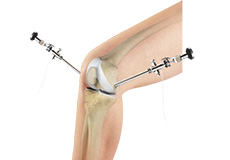
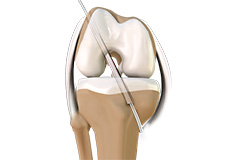
ACL reconstruction is commonly performed in younger people with a sporting injury, and its aim is to restore the joint to as near a natural state as is possible. It uses the person’s own tissues to “reconstruct” the knee to its former state. It is totally different to a “replacement” which is used for older people with a damaged knee. The anterior cruciate ligament is one of the major stabilizing ligaments in the knee. It is a strong rope like structure located in the centre of the knee running from the femur to the tibia. When this ligament tears unfortunately it doesn’t heal and often leads to the feeling of instability in the knee.
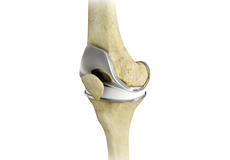
Total Knee Replacement
A knee replacement is a procedure performed to fix the damaged parts of a knee with different types of implants. Advanced technology like robotic-assisted devices can help your surgeon perform a precise knee replacement surgery personalized for your specific anatomy. Dr Wheatley uses the VELYS™ Robotic-Assisted Solution to assist him in optimising your surgical outcome. (read more in the next section). Knee replacement surgery is the last resort to relieve pain and restore function in a knee damaged by arthritis or an injury, when non-surgical treatments do not relieve the condition. It is an artificial device, and can never replicate the wondrous complexity and function of a well-performing natural human knee. It is totally different to a “reconstruction” which is performed in a younger person with a damaged ligament and which uses the natural tissue of that person to reconstruct the specific ligament.
Ideally a replacement should be reserved for people over sixty-five years of age with significant pain, deformity and disability. It can be performed in younger people, however the satisfaction rates are lower and the failure rates higher than in the older group.
The procedure involves replacing the damaged surfaces of the articulating bones with man-made implants. Deformity is corrected, and the painful joint surfaces no longer rub on each other. Satisfaction rates world-wide are of the order of eighty percent. Published data suggests ten percent of people never like their new knee. Depression, anxiety, obesity and high pre-operative use of strong pain-killers and anti-depressants are associated with lower satisfaction levels. In some people, the soft tissues around the knee remain sore for an extended period of time. The new joint surfaces cannot feel pain, and also cannot give joint-position feedback to the person. This is probably why they rarely feel “normal”. Realistic expectations, patience and hard work will usually result in a favourable outcome.
Robotic-Assisted Surgery for Total Knee Replacement
The VELYS Robotic-Assisted Solution uses a variety of advanced technologies to ensure the surgeon has the information and tools they need to perform a highly accurate and precise knee replacement1. This solution is designed to:
- Aid your surgeon by accessing state-of-the-art technology to provide insights for real-time decision making
- Help your surgeon remove the damaged bone with accuracy. This robotic-assisted device does not move or operate on its own.
- Use an infrared camera and optical trackers to help your surgeon gather the necessary data about your anatomy to achieve a high level of precision
What are the benefits of using robotic-assisted technology?
There are a number of potential benefits to using this technology for your knee replacement. During your procedure, the technology will gather details and data related to your knee to help find a favourable implant fit. Additionally, robotic-assisted technology may allow your surgeon to perform a knee replacement tailored to you, while providing both precision and accuracy during your procedure.
Robotic-assisted technology may deliver:
- A greater range of motion (how well you can bend and flex your knee after surgery)
- Less pain compared to traditional methods
- Faster recovery times (reduced length of hospital stay, hospital readmissions, and health visits)

Knee Arthroscopy
Knee Arthroscopy is a common surgical procedure performed using an arthroscope, a viewing instrument, to look inside the knee joint to diagnose or treat a knee problem. It is a relatively safe procedure and most patients discharge from the hospital on the same day of surgery.
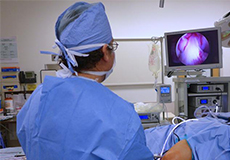
Arthroscopic Debridement
Osteoarthritis is the most common form of arthritis which affects the articular cartilage (tissue covering the ends of the bones) of the knee and other joints such as shoulder, hip, ankle and foot. The articular cartilage cushions the joint so that there is smooth and pain-free movement between the bones in the joint. In this condition, the articular cartilage is completely worn off, as a result the ends of the bones rub against each other causing pain and inflammation. Debridement was once commonly used for arthritis, however recent research suggests it is of little long-term value.

Partial Meniscectomy
Partial meniscectomy is a surgical procedure to remove the torn portion of the meniscus from the knee joint. The meniscus is the C-shaped cartilage located in the knee that lubricates the knee joint, acts as a shock-absorber, and controls the flexion and extension of joint. Meniscal tears can occur at any age, but are more common in athletes playing contact sports.
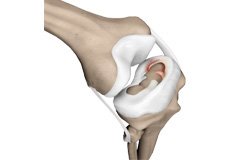
Meniscal Surgery
Meniscus tear is the commonest knee injury in athletes, especially those involved in contact sports. A suddenly bend or twist in your knee can cause the meniscus to tear. This is a traumatic meniscus tear. These injuries in younger people with supple tissues can often be successfully repaired.
Older people are more prone to degenerative meniscal tears as the cartilage slowly weakens and dies with age. Scientific studies have shown that it is very common for older people with no knee pain to have “meniscus tears” reported on MRI scans. It is debatable whether key-hole treatment of these gives any long-term benefit to the patient.
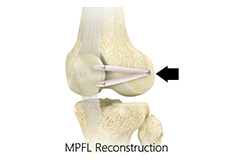
Medial Patellofemoral Ligament Reconstruction
Medial patellofemoral ligament reconstruction is a surgical procedure indicated in patients with more severe patellar instability. The medial patellofemoral ligament is a band of tissue that extends from the femoral medial epicondyle to the superior aspect of the patella.
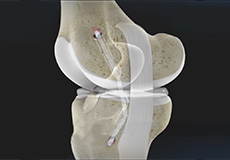
PCL Reconstruction
The posterior cruciate ligament (PCL) is one of four major ligaments of the knee situated at the back of the knee. It connects the thighbone (femur) to the shinbone (tibia). The PCL limits the backward motion of the shinbone.




